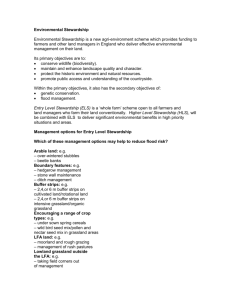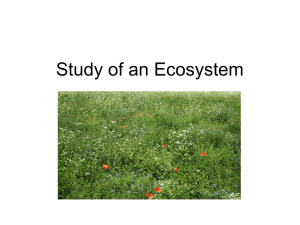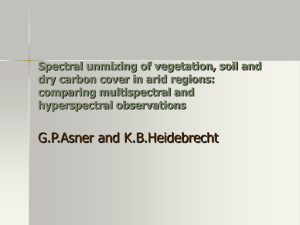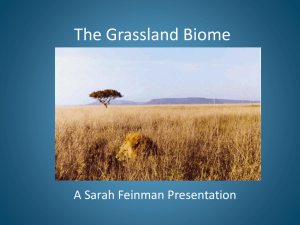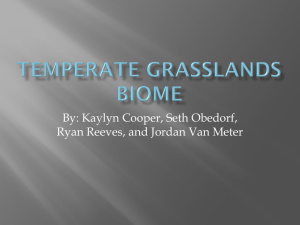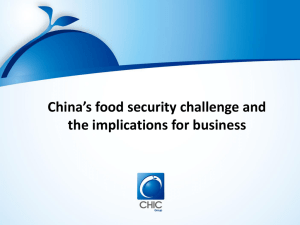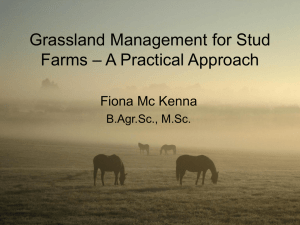4. Arable land conversion - the River Basins network`s Web platform
advertisement
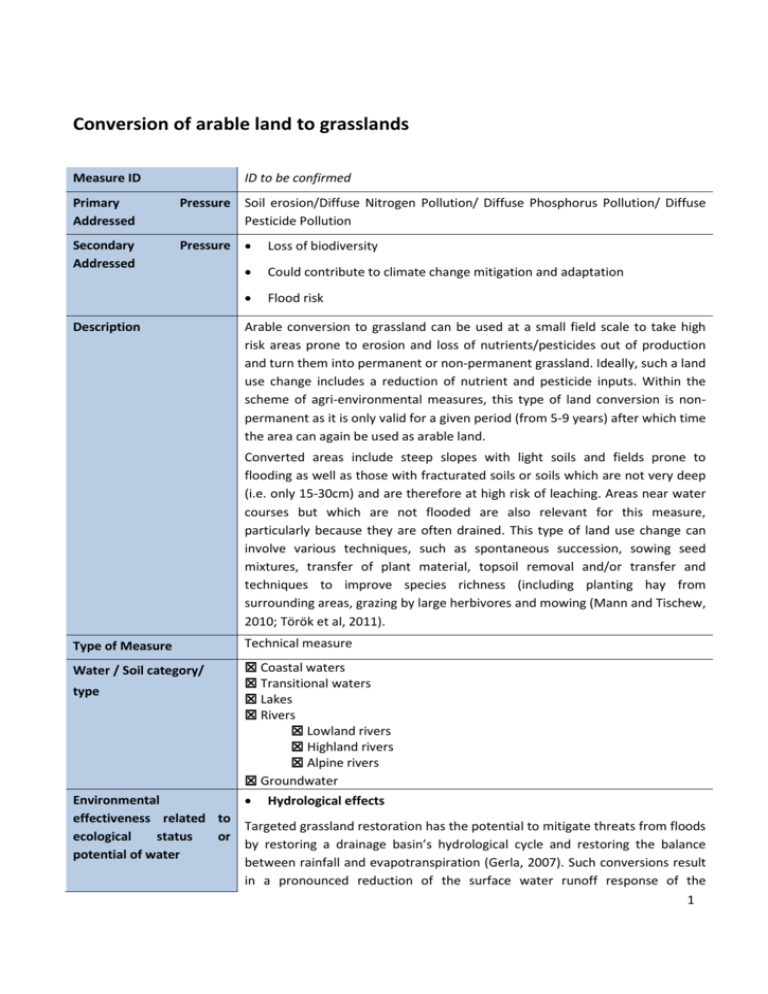
Conversion of arable land to grasslands Measure ID ID to be confirmed Primary Addressed Pressure Soil erosion/Diffuse Nitrogen Pollution/ Diffuse Phosphorus Pollution/ Diffuse Pesticide Pollution Secondary Addressed Pressure Description Loss of biodiversity Could contribute to climate change mitigation and adaptation Flood risk Arable conversion to grassland can be used at a small field scale to take high risk areas prone to erosion and loss of nutrients/pesticides out of production and turn them into permanent or non-permanent grassland. Ideally, such a land use change includes a reduction of nutrient and pesticide inputs. Within the scheme of agri-environmental measures, this type of land conversion is nonpermanent as it is only valid for a given period (from 5-9 years) after which time the area can again be used as arable land. Converted areas include steep slopes with light soils and fields prone to flooding as well as those with fracturated soils or soils which are not very deep (i.e. only 15-30cm) and are therefore at high risk of leaching. Areas near water courses but which are not flooded are also relevant for this measure, particularly because they are often drained. This type of land use change can involve various techniques, such as spontaneous succession, sowing seed mixtures, transfer of plant material, topsoil removal and/or transfer and techniques to improve species richness (including planting hay from surrounding areas, grazing by large herbivores and mowing (Mann and Tischew, 2010; Török et al, 2011). Type of Measure Technical measure Water / Soil category/ Coastal waters Transitional waters Lakes Rivers Lowland rivers Highland rivers Alpine rivers Groundwater type Environmental Hydrological effects effectiveness related to Targeted grassland restoration has the potential to mitigate threats from floods ecological status or by restoring a drainage basin’s hydrological cycle and restoring the balance potential of water between rainfall and evapotranspiration (Gerla, 2007). Such conversions result in a pronounced reduction of the surface water runoff response of the 1 watershed in question as well as an increase in subsurface storage (Kovar and Vassova, 2010). Wet grasslands in particular can serve as a buffer zone for agricultural runoff (Manchester, 1999). Measures in Niedersachsen (DE) and Umbria (IT) have had positive impacts on soil quality and erosion, particularly the use of arable set-aside and reversion of arable land to grassland. Physicochemical effects In converting arable land to permanent or non-permanent grassland, the loads of nutrients, pesticides, sediments and organic substances can be lowered (e.g. Fezzi et al, 2008; Newell Price et al, 2011). This occurs, for example, as a result of the decreased inputs of N and reduced or eliminated pesticide use as well as N uptake by the continuous vegetative cover and immobilisation into accumulating soil organic matter (Cuttle et al., 2007). Converting cropland into permanent grassland also avoids the frequent cultivations responsible for stimulating the mineralisation of ogranic matter and increasing the level of NO3 available for leaching (Newell Price et al, 2011). Permanent grasslands are moreover recognized as a measure to mitigate added atmospheric CO2 as soil organic-carbon stocks (Don et al., 2009). Furthermore, the permanent vegetative cover of grasslands will reduce soil erosion (Newell Price et al, 2011). By taking small areas prone to erosion out of production, losses of sediment and associated P can also be reduced (Cuttle et al., 2007). Effects on WFD quality elements Based on literature and case studies Biological Quality Elements Certainty of Effects Fishes Benthic macroinvertebrates Macroalgae Phytoplankton Unknown Unknown Unknown unknown Physico-chemical quality elements Certainty of effects Pesticides Nitrogen Phosphorus others (e.g.organic biodegradable, temperature) high high high unknown Hydro-morphological quality elements Certainty of effects 2 Quantitative improvement hydrological regime flow capacity and dynamics connection to groundwater unknown unknown continuity – nutrients, sediment, species upstream continuity downstream continuity river-floodplain connection unknown unknown unknown morphology - bed, banks and riparian zone composition and diversity of substrate width/depth variation diversity of structure unknown unknown unknown Estimations of the effect of cropland to grassland conversion suggest that given a five and 25 year 24-hour rainfall recurrence, the average reduction in peak run-off will range from 50 to 55% and 40 to 45%, respectively, for the basin in question; however, accurate predictions require site-specific analyses for specific watersheds (Gerla, 2007). Using a model, the effects on the local water balance from converting 10% of arable land into permanent grassland were simulated for a catchment in the Czech Republic; the results are shown below: Scenario simulation of water balance of the Němčický Stream catchment (in mm) Water balance component (mm) Actual land use Scenario land use 2001 2001 2003 2001 2002 2003 Precipitation (SP) Total runoff (STF) Surface runoff (from STF) (SOF) Base flow (BF) Actual evapotranspiration (SAE) Change in unsaturated zone storage (ASM) Change in groundwater storage (GWS) 457.8 87.3 38.2 521.6 63.9 58.3 325.8 72.4 28.5 457.8 82.6 31.8 521.6 58.5 43.0 325.8 69.8 26.5 49.1 382.7 5.6 358.7 43.9 366.0 50.8 382.9 15.5 359.4 43.3 366.0 -116.6 -52.3 -127.7 -53.8 125.4 104.7 152.6 15.4 119.1 111.4 169.0 17.7 Change in storage (DW) -11.8 100.3 -112.3 -7.7 103.7 -110.0 subsurface Source: Kovar and Vassova (2010) In converting arable land to grassland, N loads in the relevant catchment were found to decrease by 22% and N concentrations by 21% (Fezzi et al., 2008). An additional study indicates that converting to ungrazed grassland would reduce NO3 losses by around 90%; annual losses on converted land would typically be <5 kg N/ha. The findings of Cuttle et al. (2007) were consisting with these 3 results, estimating the reduction in nitrate losses to be >95% and annual losses to be about 2 kg N/ha of converted land; however, if extensive grazing takes place on the converted land, losses can reach 20 kg N/ha/year. Additionally, ammonium and nitrite losses to water would be reduced and direct and indirect N2O and NH3 emissions would decrease by around 90% (Newell Price et al, 2011). With regards to P, converting arable land without grazing corresponded to a 50% reduction in the loss of P, and adding extensive grazing resulted in a 42% reduction (Cuttle et al., 2007). Additional effects were found for energy use and carbon storage as well as soil erosion. More specifically, energy use would be reduced and carbon storage in the grassland soils would be increased, initially in the range of 1.9 to 7.0 tCO2e/ha/year; these increases would however not likely be sustained over the longer-term (>50 years) as a new soil carbon equilibrium level would be reached (Newell Price et al, 2011). Finally, in Umbria (IT), organic farming techniques have been found to reduce soil erosion on average by 6,8 ton/ha/a. Conversion of arable to grassland is estimated to have resulted in a reduction of 30/ton/ha/a. Certainty of effectiveness High Negative side effects of Regarding the objective of conservation and considering the economic aims of measure converting to grassland, high levels of biodiversity are ususally confined to less productive areas generally having a low carrying capacity for livestock and therefore low marginal returns. This means that the “management of grasslands to maintain high biodiversity is generally incompatible with management for maximum economic profit” (European Commission, 2011: 16). Research gaps related to Given the complex interactions of factors during grassland succession, effectiveness additional research is necessary on the functional attributes of “seminatural grasslands, as well as the methods required to restore localised types, novel nutrient depletion techniques, the ‘phased’ introduction of desirable but poorperforming species and the performance of different genotypes during grassland restoration,” (Walker et al, 2004: 1). Environmental effects not Converting cropland into permanent grassland is widely acknowledged as a related to water measure to mitigate added atmospheric CO2 as soil organic-carbon (SOC) stocks. In fact, SOC stocks can increase by 19% by converting arable land to grassland (e.g. Ostle et al, 2009), thereby sequestering an average of 332 kg C ha–1 y–1 for a limited time period of a few decades (Don et al, 2009). In France, the average difference between the two land types was estimated to be 25 t C ha–1 for 0–30 cm soil depth, with higher stocks in grasslands (Don et al, 2009). Soil carbon stocks in grasslands can be increased by several measures, including reducing grazing intensity, increasing grassland productivity, managing species for enhanced carbon storage, and reducing lime and N fertilizer additions (Ostle et al, 2009). 4 A significant reduction in soil C/N ration was identified over a course of 8 years in grass-arable rotations, regardless of sward type and the proportion of grassland in the rotation (Eriksen, 2008). In another study, trajectories between 30-60 years were used for conversion to grassland from arable land in Germany. Here, C/N ratios between 11-12 and an increase of soil C from 53 to 64 t ha−1 and soil N from 4.8 to 5.5 t ha−1 were calculated; younger grassland showed even higher C and N soil contents of around 60 t ha−1 for soil C and 6 t ha−1 for soil N, respectively (Breuer et al, 2006). Regarding the vegetation level, the ecological effects of conversion are highly dependent on the intensity of the former arable land management (e.g. the nutrient balance and seed bank) as well as on the initial conditions of the grassland succession (e.g. seed mixture) (Perner and Malt, 2003). That being said, using grazing with large herbivores on former arable land enables the successive development of species-rich grasslands and can enhance the colonization of native species (Mann and Tischew, 2010). In a Slovakian demonstration trial, restoration of grasslands via the transfer of seed and plant material as dry and green hay to the receptor site resulted in a transfer of 22/26 target species – an 84.6% successful transmission rate (Martincová et al, 2011). Grasslands additionally offer recreational benefits to humans as they allow increased access that is not necessarily offered by agricultural land uses (Martincová et al, 2011). Time Scale to become While extensive cutting and grazing management facilitate diversification and effective re-colonisation on former arable soils, the rates of re-assembly of plant communities with an affinity for existing semi-natural grasslands are generally slow (Walker et al, 2004). However, ‘‘nutrient stripping’’ and sowing on such exarable land areas with diverse seed mixtures has been shown to result in a rapid development of species-rich swards (Walker et al, 2004). In most cases, converting arable to permanent grassland also has rapid effects on losses of NO3 in drainage waters due to the removal of cultivations that frequently take place under arable cropping (Newell Price et al, 2011). In terms of phosphorous, however, areas which were previously intensively fertilized are not likely to have significant reductions in the leaching of soluble P until at least 10 years have passed because there are effectively no nutrient offtakes in grazed grass/livestock products; a more immediate effect is the reduction of P losses in surface run-off (Cuttle et al, 2007; Newell Price et al, 2011). Regarding pH, the level tends to decrease with increases in a grassland’s age due to the lingering influences of former agricultural practices on cropland, such as liming (Breuer et al, 2006). Estimated Operation Costs The sustainability of this nitrate reduction measure creates a high level of costeffectiveness (Fezzi et al, 2008). According to one report, the cost effectiveness 5 (given by the ratio of catchment aggregate economic impact to the reduction in N mean concentration at the catchment outlet) for conversion to grassland was -4.8 £/mg [-5.9 €/mg] (Fezzi et al, 2008). Estimated total costs Newell Price et al (2011) estimate the total costs for various farming systems as follows; the costs are based on a reduction in cropped area (assumed to be 10% of all arable land) and loss of gross margin (as fixed costs stay the same): Total cost for farm Dairy system (£/farm) Annual 200 Source: Newell Price et al (2011) Grazing low 200 Mixed 2,200 Comb crops 7,500 Comb/ roots 35,000 Hort 9,500 According to Hoving (2005), grassland renovation is a relatively expensive activity; however, completing a cost/benefit analysis is difficult given that financial benefits are more complicated to appraise. Nevertheless, the extent of measures needed to ensure the desired water levels will be a major influencing factor on overall costs incurred (Manchester, 1999). Funding options Funding for the measure is available in Rural Development Plans. The average payment rate for the conversion of arable land to grassland as an environmental land use change is currently €313 per ha with the minimum rate of €101 per ha in Hungary and a maximum of €733 per ha in the UK (European Commission, 2011). Social aspects implementation constraints and An evaluation conducted by the European Commission on measures applied to agriculture showed low farmer interest. This might be explained by the fact that many of the measures designed to save water call for substantial changes in farming practices. For instance, in Umbria (Italy), there was very little uptake of measures involving conversion of arable to grassland (European Commission, 2005). Case studies/ best practice Arable Reversion to Grassland Support Scheme, Scotland examples Driving force The quality of Scotland's water environment is generally good, but many of Scotland's river water bodies are at risk of not meeting the Water Framework Directive (WFD) objectives due to diffuse water pollution, principally from agriculture and forestry. Impact The project will provide benefits to water, and potentially to soil quality and biodiversity. Project description 6 The aim of this option is to convert problem areas within arable fields that are prone to flooding, run-off and/or erosion to permanent grassland. The grass sward must be established by sowing a suitable mix of grass seed, which may include one or more species of nectar-feeding plant, such as red clover, into a sterile seedbed. A normal medium to long term grass ley mixture would be suitable provided that it has a component of seeds of flowering plants. Once the sward is established, it must be maintaind for 5 years without applying lime, fertilisers or pesticides or being cultivated. Project effects Arable reversion to grassland will reduce nitrate leaching, soil erosion risk and the transport of sediment and associated phosphate to watercourses as well as have associated biodiversity benefits. The permanent vegetation cover minimises the erosion of soil particles and thus the loss of P in surface run-off. Country, river Scotland Costs Types of costs include: (1) fences, gates and gate removal; (2) capital works required for Sites of Special Scientific Interest (SSSI) and Natura features; and (3) renewable energy powered pumps for water troughs. For 5 years, £240.74 [€295] per hectare is paid for the conversion of grassland and £207 [€253] is paid per hectare for management. Source: http://www.scotland.gov.uk/Topics/farmingrural/SRDP/RuralPriorities/Options /Arablereversiongrassland Use of protection zones to restore contaminated groundwater, Denmark Driving force Given that over 99% of Denmark's drinking water supply derives from the nation's naturally pure groundwater, protection of the groundwater resource from agricultural and industrial contamination is a top priority. Agricultural use of nitrate fertilizers have the potential to deteriorate the quality of the groundwater, as is the case in Aarhus County. Here, more than 100 of the 600 waterworks have been closed due to nitrate contamination. In the 1980s, the nitrate content of the drinking water increased so much that action was needed to ensure compliance with the EU contamination standards for groundwater. Impact Protection zones can function to restore contaminated groundwater and ensure pure groundwater. Additionally, permanent grassland can be used as a 7 tool to reduce nitrate leaching rapidly and effectively. Project description This sustainable water supply project is the first in Danish history to use protection zones to safeguard groundwater from the effects of agricultural production. In 1989, an inner protection zone with permanent grassland was established around the abstraction wells in which the application of nitrogen fertilizer was prohibited; an additional outer protection zone extending out to a radius of 300 metres was also created in which the use of nitrogen fertilizer was strictly regulated at low levels. Project effects After 1 year, the nitrate concentration in the new groundwater formed under the grassland remained around 1 mg/l. After 5 years, the pure groundwater reached the water table and, after ten years, the upper meters of the groundwater underneath the inner protection zone became completely pure. Country, river Denmark Costs Solution (1986 prices) Protection zones Monitoring Water treatment Import of water by tanker Import of water by pipeline Establishment EUR 27,000 EUR 53,000 EUR 270,000 EUR 9,000 EUR 480,000 Annual running cost EUR 300 EUR 11,000 EUR 27,000 EUR 35,000 EUR 53,000 Source: Thomsen and Thorling (2003); Thomsen (ND) 8 Reference/ Literature Cuttle, S.P., Macleod, C.J.A., Chadwick, D.R., Scholefield, D., Haygarth, P.M., Newell-Price, P., Harris, D., Shepherd, M.A., Chambers, B.J., Humphrey, R. (2007). An inventory of methods to control diffuse water pollution from agriculture (DWPA): User Manual. Prepared as part of Defra Project ES0203. Breuer, L., Huisman, J.A., Keller, T., Frede, H.G. (2006). Impact of a conversion from cropland to grassland on C and N storage and related soil properties: Analysis of a 60-year chronosequence. Goederma 133: 6-18. Don, A., Scholten, T., Schulze, E.D. (2009). Conversion of cropland into grassland: Implications for soil organic-carbon stocks in two soils with different texture. J. Plant Nutr. Soil Sci. 172: 53-62. Eriksen, J., Askegaard, M., Soegaard, K. (2008). Residual effect and nitrate leaching in grass-arable rotations: effect of grassland proportion, sward type and fertilizer history. Soil Use and Management 24: 373-382. European Commission (2011). SEC(2011) 1153 Final/2. Commission Staff Working Paper – Impact Assessment Common Agricultural Policy towards 2020 Annex 2C. Brussels, 20.10.2011. European Commission (2005). Agri-environment Measures – Overview on General Principles, Types of Measures and Application, DG for Agriculture and Rural Development, Unit G-4. Available online: http://ec.europa.eu/agriculture/publi/reports/agrienv/rep_en.pdf Fezzi, C. Hutchins, M. Rigby, D., Bateman, I.J., Posen, P., Hadley, D., DeflandreVlandas, A. (2008). Integrated assessment of WFD nitrate reduction measures. CSERGE Working Paper ECM 08-02. Gerla, P. (2007). Estimating the effect of cropland to prairie conversion on peak storm run-off. Restoration Ecology 15 (4): 720-730. Hoving, I.E. (2005). Economy of grassland renovation: a model approach. In: Land use systems in grassland dominated regions, Proceedings of the 20th General Meeting of the European Grassland Federation, Lüzern, Swiss, 21-24 June 2004. - Grassland Science in Europe 9 (2005). - p. 544 - 546. Zürich: Arbeitsgemeinschaft zur Förderung des Futterganes (AGFF), 2005 - ISBN 3728129402. Kovar, P., Vassova, D. (2010). Impact of arable land to grassland conversion on the vegetation-period water balance of a small agricultural catchment (Nemcicky Stream). Soil and Water Res 5 (4): 128-138. Manchester, S.J., McNally, S., Treweek, J.R., Sparks, T.H., Mountford, J.O. (1999). The cost and practicality of techniques for the reversion of arable land 9 to lowland wet grassland – an experimental study and review. Journal of Environmental Management 55: 91-109. Mann, S., Tischew, S. (2010). Restoration of species-rich grasslands on former arable land by spontaneous colonization, hay transfer, and with megaherbivore grazing. Proceedings 7th European Conference on Ecological Restoration. Avignon, France, 23-27.08.2010. Martincová J., Kizeková M., Čunderlík J., Ondrášek Ľ., Pollák Š. (2011). Establishment of species-rich grasslands on arable land. Grassland Science in Europe, Vol. 16. Newell Price, JP; Harris, D; Taylor, M; Williams, JR; Anthony, SG; Duethmann, D; Gooday, RD; Lord, EI; Chambers, BJ; Chadwick, DR; Misselbrook, TH (2011). An inventory of mitigation methods and guide to their effects on diffuse water pollution, greenhouse gas emissions and ammonia emissions from agriculture. Prepared as part of Defra Project WQ0106. Ostle, N.G., Levy, P.E., Evans, C.D., Smith, P. (2009). Review: UK land use and soil carbon sequestration. Land Use Policy 265: 5274-5283. Perner, J., Malt, S. (2003). Assessment of changing agricultural land use: response of vegetation, ground-dwelling spiders and beetles to the conversion of arable land into grassland. Agriculture, Ecosystems and Environment 98: 169181. Thomsen, R (ND). Protection zones and land management to restore contaminated groundwater on the island of Tuno. Danish Ministry of the Environment: Danish Action Plan for promotion of eco-efficient technologies. Available at: www.ecoinnovation.dk/english. Thomsen, R. and L. Thorling (2003), Use of protection zones and land management restore contaminated groundwater in Denmark, Eos Trans. AGU, 84(7), 63, doi:10.1029/2003EO070005. Török. P: Vida, E; Deak, B; Lengyel, S; Tothmeresz, B (2011). Grassland restoration on former croplands in Europe: an assessment of applicability of techniques and costs. Biodivers Conserv 20: 2311-2332. Walker, K.J., Stevens, P.A., Stevens, D.P., Mountford, J.O., Manchester, S.J., Pywell, R.F. (2004). The restoration and re-creation of species-rich lowland grassland on land formerly managed for intensive agriculture in the UK. Biological Conservation 119: 1-18. 10
